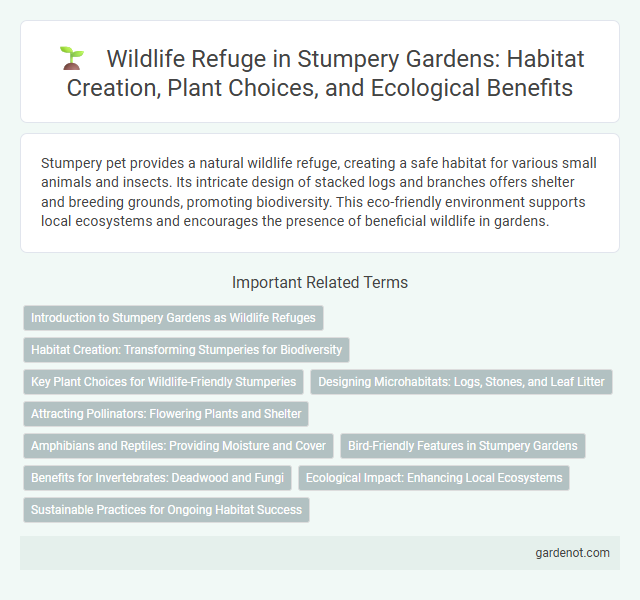Stumpery pet provides a natural wildlife refuge, creating a safe habitat for various small animals and insects. Its intricate design of stacked logs and branches offers shelter and breeding grounds, promoting biodiversity. This eco-friendly environment supports local ecosystems and encourages the presence of beneficial wildlife in gardens.
Introduction to Stumpery Gardens as Wildlife Refuges
Stumpery gardens serve as vital wildlife refuges by offering essential habitats for diverse species, including insects, amphibians, and small mammals. These unique landscapes mimic natural woodland environments, providing shelter, nesting sites, and food resources within decaying wood structures. Their intricate design supports biodiversity conservation and enhances urban ecosystems by fostering microhabitats that sustain local wildlife populations.
Habitat Creation: Transforming Stumperies for Biodiversity
Stumperies create diverse microhabitats by combining rotting wood, stones, and plants, providing shelter for insects, amphibians, and small mammals. These structures enhance soil health and moisture retention, fostering a variety of fungi and moss species essential for ecosystem balance. By mimicking natural forest floor conditions, stumperies contribute significantly to biodiversity conservation in wildlife refuges.
Key Plant Choices for Wildlife-Friendly Stumperies
Key plant choices for wildlife-friendly stumperies include native ferns, mosses, and shade-loving perennials such as hostas and hellebores, which provide shelter and food for various insects and small mammals. Incorporating deadwood and decaying logs enhances biodiversity by offering nesting sites for beetles and amphibians. Selecting plants that support pollinators like bees and butterflies improves the ecological value of a stumpery as a wildlife refuge.
Designing Microhabitats: Logs, Stones, and Leaf Litter
Designing microhabitats in a stumpery involves arranging logs, stones, and leaf litter to create diverse shelters for wildlife refuge, promoting biodiversity by mimicking natural forest floor conditions. Decaying logs provide essential habitats for fungi, insects, and amphibians, while stones offer basking sites and refuge for reptiles and invertebrates. Leaf litter enriches soil fertility and serves as nesting material and camouflage, supporting small mammals and ground-nesting birds within the ecosystem.
Attracting Pollinators: Flowering Plants and Shelter
Stumperies provide an ideal habitat for pollinators by combining flowering plants with natural shelters formed from decaying wood and stumps. These structures create microhabitats that support bees, butterflies, and other beneficial insects by offering nectar sources and protective cover essential for nesting and overwintering. Integrating native flowering species like foxglove, primrose, and lungwort enhances biodiversity and strengthens local pollinator populations within wildlife refuges.
Amphibians and Reptiles: Providing Moisture and Cover
Stumperies create ideal habitats for amphibians and reptiles by offering abundant moisture and natural cover through decaying wood, moss, and leaf litter. These environments support species like newts, frogs, slow worms, and grass snakes by maintaining the damp conditions necessary for their survival and providing shelter from predators. Incorporating stumps and logs encourages biodiversity within a wildlife refuge by fostering microhabitats critical for the lifecycle of these moisture-dependent species.
Bird-Friendly Features in Stumpery Gardens
Stumpery gardens create ideal wildlife refuges by incorporating bird-friendly features such as dense log piles and native shrubbery that provide shelter and nesting sites for various bird species. The structural complexity of stumperies supports insect populations, which serve as vital food sources for insectivorous birds. These gardens enhance local biodiversity and promote conservation by offering safe habitats within urban and suburban landscapes.
Benefits for Invertebrates: Deadwood and Fungi
Stumperies provide crucial habitats for invertebrates by offering a rich supply of deadwood, which supports diverse beetle larvae, woodlice, and other decomposers. The fungi growing on decaying wood enhance nutrient cycling and create microhabitats, fostering biodiversity within these ecosystems. This combination of deadwood and fungal presence helps maintain healthy populations of pollinators and detritivores essential for forest ecosystems.
Ecological Impact: Enhancing Local Ecosystems
Stumperies create vital habitats by providing shelter and breeding grounds for diverse wildlife such as insects, amphibians, and birds, significantly boosting local biodiversity. The decaying wood in stumperies enriches soil quality and supports fungi and microorganisms essential for nutrient cycling. These structures help stabilize microclimates, promoting ecological balance and resilience within surrounding ecosystems.
Sustainable Practices for Ongoing Habitat Success
Stumperies create essential wildlife refuges by repurposing fallen wood, supporting biodiversity through microhabitats for insects, amphibians, and small mammals. Employing sustainable practices such as sourcing dead wood locally and avoiding chemical treatments maintains soil health and promotes natural decomposition cycles. Continuous monitoring and adaptive management ensure these habitats evolve, enhancing long-term ecological balance and resilience.
Wildlife refuge Infographic

 gardenot.com
gardenot.com